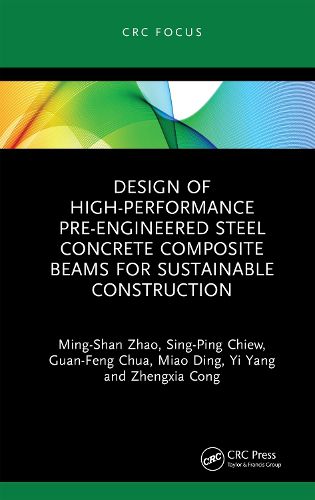Readings Newsletter
Become a Readings Member to make your shopping experience even easier.
Sign in or sign up for free!
You’re not far away from qualifying for FREE standard shipping within Australia
You’ve qualified for FREE standard shipping within Australia
The cart is loading…






This accessible and practical shortform book details the properties and advantages of high-performance pre-engineered steel-concrete composite beams (HPCBs) for improving the sustainability of construction techniques. It also explains the analysis methods for testing HPCB systems.
The authors describe a new HPCB system that has been developed to reduce the input of raw materials and embodied CO2 commonly associated with heavily loaded and long-spanned industrial buildings (which predominately comprise reinforced concrete) and improve the sustainability of the construction process. They provide several resources throughout to facilitate adoption by professionals.
Design equations derived from Eurocode 4 approach for ultimate limit state and serviceability limit state and worked examples are included throughout. The authors discuss the feasibility for both materials and the full-scale beams and CO2 reduction methods, including use of recycled concrete aggregate, ground granulated blast-furnace and silica fume to replace natural coarse
aggregates and Ordinary Portland Cement. Guidance for testing HPCBs-including setup, test procedure and data collection and interpretation-is also given. The authors also elaborate on recommendations for finite element analysis for HPCBs. Design examples are appended to illustrate typical current practice using a 12 x 12 m grid floor with live load of 15 kPa. Various considerations for different parameters such as fire resistance are discussed. Finally, the authors present a case study of a recently completed industrial building in Singapore to quantify the benefits of using HPCBs over reinforced concrete and conventional composite construction.
Structural engineering professionals, whose work relates to long-span and heavy-loading industrial or commercial buildings, will benefit from the detailed guidance and focus on practical applications provided throughout this book. Post-graduate students of advanced steel and composite structures will also benefit from these descriptions.
$9.00 standard shipping within Australia
FREE standard shipping within Australia for orders over $100.00
Express & International shipping calculated at checkout
This accessible and practical shortform book details the properties and advantages of high-performance pre-engineered steel-concrete composite beams (HPCBs) for improving the sustainability of construction techniques. It also explains the analysis methods for testing HPCB systems.
The authors describe a new HPCB system that has been developed to reduce the input of raw materials and embodied CO2 commonly associated with heavily loaded and long-spanned industrial buildings (which predominately comprise reinforced concrete) and improve the sustainability of the construction process. They provide several resources throughout to facilitate adoption by professionals.
Design equations derived from Eurocode 4 approach for ultimate limit state and serviceability limit state and worked examples are included throughout. The authors discuss the feasibility for both materials and the full-scale beams and CO2 reduction methods, including use of recycled concrete aggregate, ground granulated blast-furnace and silica fume to replace natural coarse
aggregates and Ordinary Portland Cement. Guidance for testing HPCBs-including setup, test procedure and data collection and interpretation-is also given. The authors also elaborate on recommendations for finite element analysis for HPCBs. Design examples are appended to illustrate typical current practice using a 12 x 12 m grid floor with live load of 15 kPa. Various considerations for different parameters such as fire resistance are discussed. Finally, the authors present a case study of a recently completed industrial building in Singapore to quantify the benefits of using HPCBs over reinforced concrete and conventional composite construction.
Structural engineering professionals, whose work relates to long-span and heavy-loading industrial or commercial buildings, will benefit from the detailed guidance and focus on practical applications provided throughout this book. Post-graduate students of advanced steel and composite structures will also benefit from these descriptions.